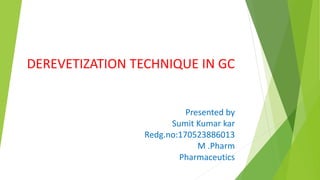
DEREVETIZATION TECHNIQUE IN GC MODERN PHARMACEUTICAL ANALLYTICAL TECHNIQUE
- 1. DEREVETIZATION TECHNIQUE IN GC Presented by Sumit Kumar kar Redg.no:170523886013 M .Pharm Pharmaceutics
- 2. INTRODUCTION: Derivatization is the process of chemically modifying a compound to produce a new compound which has properties that are suitable for analysis using a GC or HPLC. The chemical structure of the compound remains the same and just modifies the specific functional groups of reacting compound to a derivative of deviating chemical and physical properties in order to make them detectable and analyzable. The compound which is chemically modified is known as the Derivative. Derivatization is needed in GC, HPLC, UV-Visible spectroscopy etc.
- 3. WHY DERIVETIZE IN GC? To permit analysis of compounds which are not directly amenable to analysis due to inadequate stability and volatility. To improve chromatographic detectability. The main reason for derivatizing is to impart volatility to non-volatile compounds. Derivatization is useful to allow the use of GC & GC/MS on sample that would other wise be not possible in various areas of chemistry such as medical, forensic & environmental.
- 4. IMPORTANCE OF DERIVETIZATION Increases volatility Eliminates the presence of polar OH, NH & SH groups. Derivatization targets O, N, S and P functional groups (with hydrogen available). Enhances sensitivity for ECD The introduction of ECD detectable groups, such as halogenated acyl groups, allows detection of previously undetectable compounds. In general, halogen substituent increases the sensitivity in electron capture detector (ECD) in the order I > Br > Cl > F. For aromatic compounds, the substituents affect the sensitivity of the ECD according to their electron withdrawing capability. Strong electron withdrawing groups such as NO2 increase the sensitivity of the detection, while electron donating groups reduce it. Increases detectability, i.e. steroids Increases stability (thermostability)
- 5. CONDITION FOR CHOOSING A DERIVETIZING AGENT The derivatizing agent must be stable. The derivatizing agent and its products formed during derivatization should not be detectable or must be separable from analyte. The analyte should be reactive with the derivatizing agent under convenient conditions. Derivatizing agent should be non-toxic.
- 6. TYPES OF DERIVETIZATION 1. SILYLATION 2. ALKYLATION 3. ACYLATION 4. CHIRAL DERIVATIZATION
- 7. 1. SILYLATION Most prevalent method, readily volatizes the sample. Mechanism: This process produces silyl derivatives which are more volatile and thermally stable. Replaces active hydrogen with TMS (trimethyl silyl groups) Silylation occurs the nucleophilic attack (SN2). The better the leaving group, the better the silylation.
- 8. SN2 REACTION MECHANISM: Order of reactivity of functional group towards silylation: 1° Alcohol > 2°alcohol > 3°alcohol > phenol > Carboxyl > Amines > Amides > Hydroxyl NOTE: Column, which have active hydrogen in the stationary phase cannot be used in silylation process, because it derivatize the silylating agent.
- 9. ADVANTAGES Ability to silylate a wide variety of compounds. Easy to prepare. DISADVANTAGES Silylating agents are moisture sensitive. Must use aprotic solvent.
- 11. SILYLATING REAGENTS AND THEIR MECHANISM
- 14. 2.ALKYLATION Alkylation reduces molecular polarity by replacing active hydrogens with an alkyl group. These reagents are used to modify compounds with acidic hydrogens, such as carboxylic acids and phenols. These reagents make esters, ethers, alkyl amines and alkyl amides. The principal reaction employed for preparation of these derivatives is nucleophilic displacement.
- 15. ADVANTAGES Alkylation derivatives are stable. Reaction condition can vary from strongly acidic to strongly basic. Limited to amines and acidic hydroxyls. Reagents are often toxic. DISADVANTAGES
- 16. MECHANISM OF ALKYLATING AGENT
- 19. 3.ACYLATION • Acylation reduces the polarity of amino, hydroxyl and thiol groups and adds halogenated functionalities for ECD. In comparison to silylating reagents, the acylating reagents target highly polar, multifunctional compounds, such as carbohydrates and amino acids. Acylation converts these compounds with active hydrogens into ester, thioesters and activated acyl amide reagents. The anhydrides and acyl halides reagents form acid by-products, which must be removed before GC analysis. Acylation is normally carried out in pyridine, tetrahydrofuran or other solvent capable of accepting the acid by-product.
- 20. ADVANTAGES Addition of halogenated carbons increased detectability by ECD. Derivatives are hydrolytically stable. Increases sensitivity by increasing molecular weight. DISADVANTAGES Acylation derivatives are difficult to prepare. Acid by-products needs to be removed before analysis. Acylation reagents are moisture sensitive. Reagents are hazardous.
- 21. ACYLATING REAGENTS AND THEIR MECHANISM
- 23. 4.CHIRAL DERIVETIZATION These reagents target one specific functional group and produce individual diastereomers of each of the enantiomers. There are two ways of separating enantiomers by chromatography: 1. Separation on an optically active stationary phase. 2. Preparation of diastereomeric derivatives that can be separated on a non-chiral stationary phase.
- 24. REAGENTS: 1. TPC (N-trifluoroacetyl-L-prolyl chloride) Used for optically active amines, most probably amphetamines. 2.MCF ((-) menthylchloroformate) Used for optically active alcohols.
- 25. FUNCTIONAL GROUP AND THEIR DERIVETIZING METHOD